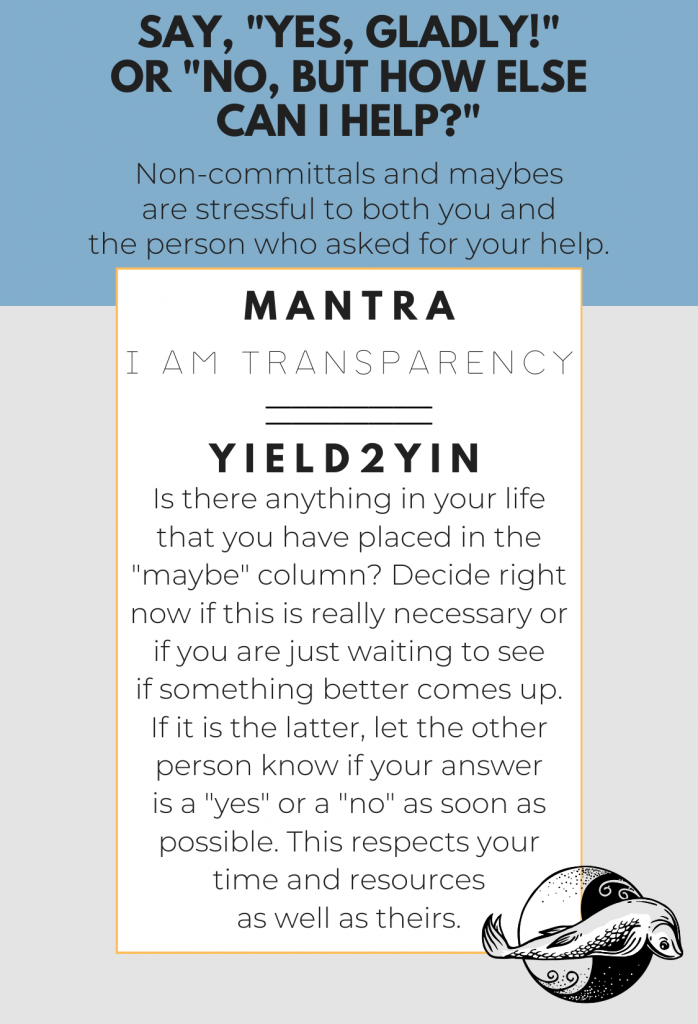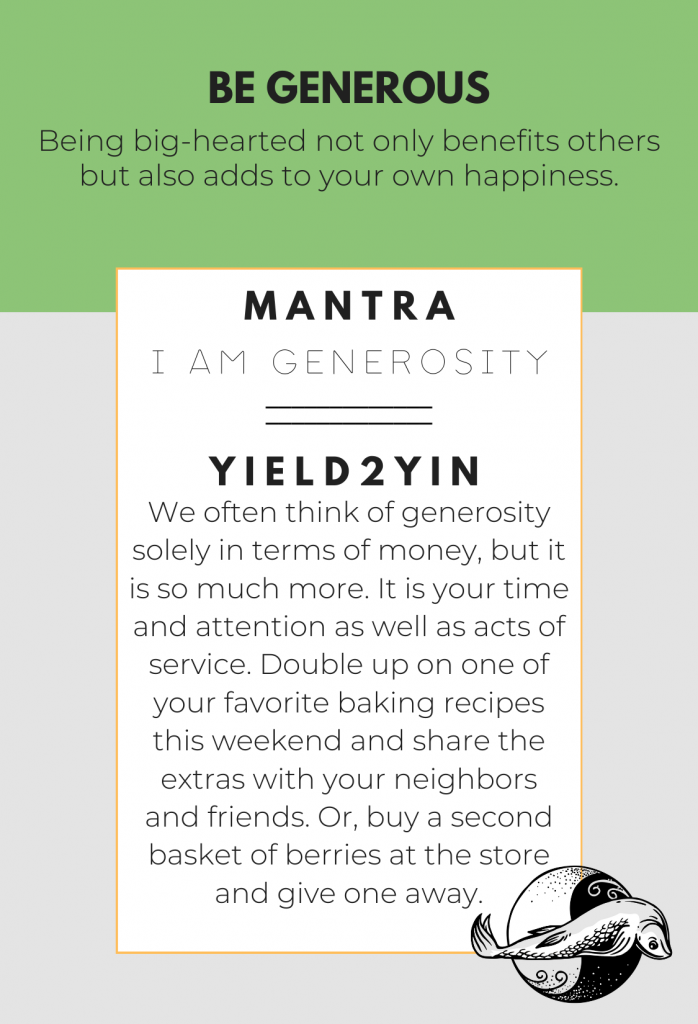Here are two things people often get wrong when it comes to generosity:
- Myth #1: Generosity is all about money
- Myth #2: Generosity is a trait of the well-resourced only
The truth is generosity can of course relate to money, but it is also about acts of service, time, and attention.
Furthermore, generosity is an attitude, a personality trait. It is more about your relationship with money, with your career, and with time and attention than it is about the amount of money you make, your daily to-do list, and the amount of time and attention you have available. It is about what you value and what you prioritize.
Just like we have a relationship with people, we have a relationship with concepts as well. Not only with concepts such as our money, the action items on our agenda, and our time and attention, but also with many other concepts, such as food, alcohol, exercise, social media, and so on.
- Are your relationships with your money, your to-do list, and your time healthy or unhealthy?
- In other words, do you have a healthy attachment or an unhealthy attachment to these 3 concepts?
- Are you securely attached or are you anxiously attached to your money, your to-do list, and your time available?
Let’s break down these forms of generosity and some common blocks people have from fully stepping into a generous spirit.
Financial Generosity
It is not because someone has more money that they are more generous with their money. More resources does not automatically mean more generosity. For example, just because somebody has a lot of extra time does not necessarily mean they exercise more than somebody who is often crunched for time.
There is no real correlation.
The difference typically comes down to A) Empathy B) Healthy financial detachment
I am not suggesting being wasteful or spending money you do not have. Not at all. I am instead suggesting being mindful about your relationship with money. Check in with yourself. Be honest with yourself. Ask yourself regularly: “Is my relationship with money a healthy one, or is there room for improvement?”
I have always liked my mother’s notion of money: “You cannot take it to your grave with you when you die, so you may as well spend it while you live.” And when she says “spend it,” she does not mean just on yourself. My mother is a very generous woman; sometimes to a fault.
If you have a tight grip on your money and you are struggling with loosening it, take a closer look at your relationship with money. A great start is to ask yourself the following 10 questions connected to your family growing up:
- Was money tight? Was there just enough or was there plentiful?
- Did your parent(s) talk a lot about their finances, incl. financial stressors? Amongst themselves? Or did they include you in their conversations?
- Did you have to work as a teenager and, if you continued your education after high school, who paid for your studies?
- How were finances dealt with in your family growing up; basically, what was your parent(s) relationship with money like? Did they financially support you as much as they could or did they mostly leave you to your own devices?
- Is your relationship with money similar or different than your family of origin’s? How is it similar? How is it different?
- How do you think the answers to the questions above have affected your relationship with money? What are some other thoughts and feelings that have come up answering these questions?
- How would you like to be perceived by others? As generous? Smart with money? Good at budgeting? Frugal? Tight?
- How do you think you are perceived by others? Is it different from how you would like to be perceived? Is it different from how you perceive yourself? If so, how?
- Would you like to change your relationship with money? If so, what is holding you back?
- When you are ready to change your relationship with money, what do you think will be the biggest struggle? Here is a related link to one of my previous blog post: Feeling Stuck? “The Stages of Change” Can Help.
Acts of Service Generosity
Next up we have acts of service generosity. This one can be tricky for people because agreeing to help someone can sometimes feel guilt-motivated. This guilt-motivation can often lead to resentment. Resentment then leads to never wanting to do anything for anybody anymore, or “compassion fatigue.”
If you struggle with offering or taking on acts of service for others, ask yourself about your relationship with helping, with codependency, with boundaries, and even with over-independence.
Generous people who want to maintain a life of generosity have to be good at saying no. That may seem counterintuitive at first, but healthy boundaries and clear communication are essential.
Start by practicing direct communication. If people ask you for a favor, be direct in your answer. Don’t leave people hanging.
- If the answer is no, just say no. You do not have to explain why; this is up to you. You can (but don’t have to) offer a different service or time or money: “Sorry I can’t do that, but I would love to (whatever you can do instead).”
- If the answer is a true maybe (for example, you genuinely want to help a friend move, but don’t know if you can secure childcare in time), simply explain why you can’t commit yet. Then give a solid yes or no as soon as you can.
- If the answer is yes, then no ifs or buts, but instead: “Would love to!” “Gladly!” “Of course!”

For sale on Amazon soon!
Next, examine your own relationship with asking for help. Ask yourself these questions:
- Do I consider asking other people for help when I need it a sign of weakness?
- Did I get a lot of “pull yourself up by your bootstraps” messaging when I was growing up?
- Do I feel worthy of receiving help?
You can also just do people favors without being asked first, of course. Sometimes that’s a great way to practice generosity because it feels safe. When you get rid of things, don’t sell them, just give them away. When you bake or cook, make extras, and give away some of the deliciousness to a neighbor, a friend who is sick, or your child’s teacher.
Time Generosity
Finally, we come to time and attention generosity. We all only have 24 hours in a day, so we cannot have or do it all. And yet, we all still need to set time aside for:
- Self-care (first and foremost! – in your mind’s eye, follow the flight attendant’s instructions: “put your oxygen mask on first before helping others”)
- Partner-care
- Family-care
- Friend-care
I’ll admit, that’s a lot to do in so little time. Try assessing your days for one week. Break your day up into big chunks with these four categories. Which section takes up the most time? Which section needs more time? While I do not recommend excessive self-care at the expense of partner, family, and friend-care, I also strongly discourage not leaving any time for self-care at all (which is what I see quite frequently when working with mothers/clients in my private practice). That’s not generosity; that’s martyrdom.
If the pendulum is swinging too far to the “self” category, it may be time to readjust. Perhaps you just don’t have enough time in this season of life to play 18 holes of golf, train for an ironman triathlon, take on a job that requires extensive business travel, and that is OK. Be flexible and patient. There will be a time in your life when you can do some or all of those things again; it does not have to be here and now.
Why is it so difficult to set work schedule boundaries in family life?
Well, here is one scenario a lot of us are all too familiar with:
Let’s say Scott and Matt are a married couple with 3 children. Scott works outside of the home as an accountant and Matt works inside the home taking care of their 3 young children as a stay-at-home dad. Scott tells Matt that he has to work late almost every night. If Matt “complains” about Scott working late hours, Scott reminds him of the pressure of being the sole financial provider for the whole family as well as of the potential risk of losing his job if he does not put in the overtime.
Now Matt finds himself between a rock and a hard place. Every time he attempts to draw a line with Scott about his work hours, he is accused of being an unsupportive spouse who does not understand nor appreciate Scott working 60-hour weeks to keep the family financially afloat and his job secure.
If Matt says nothing and gives Scott free rein with his work schedule, Matt is left with the daily hectic family evening grind–when the kids are at their most tired, taking care of dinner, bath, and bedtime all by himself. You can see why Matt then starts building resentment towards Scott for the same reasons: not being understood nor appreciated, especially since his household chores are invisible and unpaid.
“I have to work late” seems to be a valid explanation for not showing up for a partner and the children, yet that does not mean it always has to fly with you. Make sure to call your partner out when you notice his working late is a cop-out out. Suggest setting better boundaries–he can tell his employer “Sorry, my family needs me right now, but I can take a look at this later on tonight or first thing in the morning.”
This is for the workaholics to consider–do you really have to work that much? Remember, anything that ends with “-holics” is referring to an addiction to something, in this case to work related activities. So, while these activities are taking up all of your time, ask yourself what it is that you’re trying to escape from? Could it be some of your other roles, such as your role as a husband or your role as a father? Could it be that staying at work is in fact easier (because it feels calmer and safer) than being home by 6pm and helping your husband with the kids’ evening routine (which, let’s face it, can at times be very chaotic and stressful)?
Finally, remember true time generosity is not only about time, but also attention. Even if you spent all day next to your child, but didn’t speak to them or even look up from your phone, you are not being generous with your attention (nor with your time, really). A few minutes of connected play with your child, using lots of eye-contact, getting on the floor with them, and pointing out things they are interested in tells them, “YOU are important to me.”
Here’s one more example of how attention can be a form of generosity. When entertaining, be sure to contribute to the conversations. Yes, you opened up your home, and provided food and drinks. But your attention can also mean the world to your guests. This is about quality time, so be attuned, curious, give undivided, positive, and supportive attention. I know this can be challenging for those who are more introverted or experience social anxiety. In this case, consider it an opportunity for personal growth and gently push yourself even though it may feel uncomfortable at first. Start by asking your guests a simple question and see where the conversation leads you: “How was your week?” or “How’s work going?” or “Any trips coming up?”
How Can I Practice Generosity?
- Practice yin yoga – money is both first chakra energy: survival, safety, and security, as well as second chakra energy: beliefs, feelings, and values, incl. around money, (as well as creativity and sexuality). One way to cleanse and balance chakras is by practicing yin yoga sessions, which include poses that target specific chakras for healing. Here is a great one for root chakra healing: Root Chakra Yin Yoga & Affirmations for Belonging & Abundance by Yoga with Kassandra (57:16 min.) And here is another one for sacral chakra healing: Sacral Chakra Yin Yoga & Affirmations for Creativity & Sensuality by Yoga with Kassandra (57:16 min.)
- Open up your fourth chakra, which is your heart chakra and is associated with the color green – if you want to be generous with your loving and healing energy, opening up your heart is a wonderful way to do that: close your eyes and imagine a glowing green light leaving your heart and wrapping someone’s (for example, a beggar on the street) entire being with the soft glow of your heartfelt, warm, and peaceful healing light. If you are curious to learn more about the heart chakra, here is a blog from a Yoga Journal I recommend: Everything You Need to Know About the Heart Chakra – Discover the physical and mental signs of blocked energy in the fourth chakra—and how to clear it.
- Listen to guided visualization meditation – click on the following link to practice gratitude and generosity: Gratitude and Generosity Meditation by Jack Kornfield (27:23 min.)
- Practice breathing meditation – breathe in what you want more of: abundance, faith, generosity, and prosperity + breathe out what you want to let go of: worries and fear (of scarcity, not having enough, being destitute, or even homeless). Click on the following link to practice a guided breathing meditation: Financial Faith | Guided Meditation for Anxiety and Fear Surrounding Money and Financial Security by Stress Free Naturally (12:02 min.)
- Do an action item – there is an unlimited amount of ways to be generous. For example, during the holiday season, you could donate bags of dry and canned food to a local food bank. Another example: if you want to donate money in support of new mothers, consider giving to “The San Diego Postpartum Health Alliance, a nonprofit dedicated to perinatal mental health awareness, education, and support.” Or if, instead, you want to buy a meaningful gift for yourself, or to support a new mother, to make motherhood easier, consider shopping with a business that does just that AND also gives back to the community – SPARK MAMAS! Here is a related link to one of my previous blog post: Helper’s High: Doing Good Is Good For You.
- Journal about what thoughts and feelings came up for you reading this generosity blog – you could write out your answers to the questions above about your relationship with money and its potential ties to your family of origin.
- BE GENEROUS is one of my cards of my upcoming A Therapist’s Advice 55-Card Healing Card Deck, which will be for sale on Amazon soon; stay tuned!

Yield2Yin
- Book Recommendation: It’s Not Your Money: How to Live Fully from Divine Abundance by Tosha Silver
- Mantra: I AM GENEROSITY // repeat with diaphragmatic breathing
- Yin Yoga Asana: Deer Pose
This page includes Amazon Associate affiliate links. This means I may earn a small commission at no cost to you if you purchase a product I suggest, and for that reason, I only recommend products I believe in. Learn more HERE.







